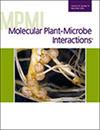Reinaldo Rodrigues de Souza-Neto, Lídia Nascimento Cavalcante, Isis Gabriela Barbosa Carvalho, Maiara Curtolo, Celso Eduardo Benedetti, Marco Aurélio Takita, Nian Wang, Alessandra Alves de Souza
求助PDF
{"title":"CRISPR/ cas9介导的CsLIEXP1断裂揭示扩张蛋白是柑橘溃疡病的关键易感因子","authors":"Reinaldo Rodrigues de Souza-Neto, Lídia Nascimento Cavalcante, Isis Gabriela Barbosa Carvalho, Maiara Curtolo, Celso Eduardo Benedetti, Marco Aurélio Takita, Nian Wang, Alessandra Alves de Souza","doi":"10.1094/MPMI-12-24-0151-R","DOIUrl":null,"url":null,"abstract":"<p><p>The <i>Citrus sinensis LATERAL ORGAN BOUNDERIES 1</i> (<i>CsLOB1</i>) gene, which is directly induced by the <i>Xanthomonas citri</i> subsp. <i>citri</i> effector PthA4, functions as a transcription factor and citrus canker susceptibility (S) gene. Genome editing of <i>CsLOB1</i> has been shown to confer resistance to citrus canker disease. Previous studies revealed that the citrus <i>CsLOB1-INDUCED EXPANSIN 1</i> gene (<i>CsLIEXP1</i>) is highly and directly upregulated by <i>CsLOB1</i> in <i>Xanthomonas citri</i> subsp. <i>citri</i>-infected plants. Because expansins are associated with cell wall loosening, potentially facilitating bacterial colonization, the <i>CsLOB1-</i>dependent activation of <i>CsLIEXP1</i> is thought to contribute to canker symptoms and disease progression. Thus, <i>CsLIEXP1</i> likely represents a critical canker susceptibility gene. In this study, we employed CRISPR/Cas9 to disrupt the function of <i>CsLIEXP1</i> by modifying its corresponding coding region in <i>Citrus sinensis</i> cultivar 'Hamlin' and evaluated the postinfection responses of edited plants. DNA sequencing confirmed the edition of the <i>CsLIEXP1</i>-edited plant, which exhibited 26.47% of <i>CsLIEXP1</i> edited sequences. Furthermore, <i>CsLIEXP1</i> protein accumulation was reduced in <i>CsLIEXP1</i>-edited plants compared with the wild type when infected with <i>X. citri</i>. Leaves of edited plants inoculated with <i>X. citri</i> showed significantly fewer canker symptoms, with lesions limited to the site of bacterial inoculation and less pronounced cellular hypertrophy compared with control plants. Our results show that <i>CsLIEXP1</i> is a citrus canker S gene that acts downstream of <i>CsLOB1</i>, thus providing new insights into plant-pathogen interactions. [Formula: see text] Copyright © 2025 The Author(s). This is an open access article distributed under the CC BY-NC-ND 4.0 International license.</p>","PeriodicalId":19009,"journal":{"name":"Molecular Plant-microbe Interactions","volume":" ","pages":"589-598"},"PeriodicalIF":3.4000,"publicationDate":"2025-07-01","publicationTypes":"Journal Article","fieldsOfStudy":null,"isOpenAccess":false,"openAccessPdf":"","citationCount":"0","resultStr":"{\"title\":\"CRISPR/Cas9-Mediated Disruption of <i>CsLIEXP1</i> Reveals Expansin as a Key Susceptibility Factor for Citrus Canker Disease.\",\"authors\":\"Reinaldo Rodrigues de Souza-Neto, Lídia Nascimento Cavalcante, Isis Gabriela Barbosa Carvalho, Maiara Curtolo, Celso Eduardo Benedetti, Marco Aurélio Takita, Nian Wang, Alessandra Alves de Souza\",\"doi\":\"10.1094/MPMI-12-24-0151-R\",\"DOIUrl\":null,\"url\":null,\"abstract\":\"<p><p>The <i>Citrus sinensis LATERAL ORGAN BOUNDERIES 1</i> (<i>CsLOB1</i>) gene, which is directly induced by the <i>Xanthomonas citri</i> subsp. <i>citri</i> effector PthA4, functions as a transcription factor and citrus canker susceptibility (S) gene. Genome editing of <i>CsLOB1</i> has been shown to confer resistance to citrus canker disease. Previous studies revealed that the citrus <i>CsLOB1-INDUCED EXPANSIN 1</i> gene (<i>CsLIEXP1</i>) is highly and directly upregulated by <i>CsLOB1</i> in <i>Xanthomonas citri</i> subsp. <i>citri</i>-infected plants. Because expansins are associated with cell wall loosening, potentially facilitating bacterial colonization, the <i>CsLOB1-</i>dependent activation of <i>CsLIEXP1</i> is thought to contribute to canker symptoms and disease progression. Thus, <i>CsLIEXP1</i> likely represents a critical canker susceptibility gene. In this study, we employed CRISPR/Cas9 to disrupt the function of <i>CsLIEXP1</i> by modifying its corresponding coding region in <i>Citrus sinensis</i> cultivar 'Hamlin' and evaluated the postinfection responses of edited plants. DNA sequencing confirmed the edition of the <i>CsLIEXP1</i>-edited plant, which exhibited 26.47% of <i>CsLIEXP1</i> edited sequences. Furthermore, <i>CsLIEXP1</i> protein accumulation was reduced in <i>CsLIEXP1</i>-edited plants compared with the wild type when infected with <i>X. citri</i>. Leaves of edited plants inoculated with <i>X. citri</i> showed significantly fewer canker symptoms, with lesions limited to the site of bacterial inoculation and less pronounced cellular hypertrophy compared with control plants. Our results show that <i>CsLIEXP1</i> is a citrus canker S gene that acts downstream of <i>CsLOB1</i>, thus providing new insights into plant-pathogen interactions. [Formula: see text] Copyright © 2025 The Author(s). This is an open access article distributed under the CC BY-NC-ND 4.0 International license.</p>\",\"PeriodicalId\":19009,\"journal\":{\"name\":\"Molecular Plant-microbe Interactions\",\"volume\":\" \",\"pages\":\"589-598\"},\"PeriodicalIF\":3.4000,\"publicationDate\":\"2025-07-01\",\"publicationTypes\":\"Journal Article\",\"fieldsOfStudy\":null,\"isOpenAccess\":false,\"openAccessPdf\":\"\",\"citationCount\":\"0\",\"resultStr\":null,\"platform\":\"Semanticscholar\",\"paperid\":null,\"PeriodicalName\":\"Molecular Plant-microbe Interactions\",\"FirstCategoryId\":\"99\",\"ListUrlMain\":\"https://doi.org/10.1094/MPMI-12-24-0151-R\",\"RegionNum\":3,\"RegionCategory\":\"生物学\",\"ArticlePicture\":[],\"TitleCN\":null,\"AbstractTextCN\":null,\"PMCID\":null,\"EPubDate\":\"2025/8/7 0:00:00\",\"PubModel\":\"Epub\",\"JCR\":\"Q2\",\"JCRName\":\"BIOCHEMISTRY & MOLECULAR BIOLOGY\",\"Score\":null,\"Total\":0}","platform":"Semanticscholar","paperid":null,"PeriodicalName":"Molecular Plant-microbe Interactions","FirstCategoryId":"99","ListUrlMain":"https://doi.org/10.1094/MPMI-12-24-0151-R","RegionNum":3,"RegionCategory":"生物学","ArticlePicture":[],"TitleCN":null,"AbstractTextCN":null,"PMCID":null,"EPubDate":"2025/8/7 0:00:00","PubModel":"Epub","JCR":"Q2","JCRName":"BIOCHEMISTRY & MOLECULAR BIOLOGY","Score":null,"Total":0}
引用次数: 0
引用
批量引用

 求助内容:
求助内容: 应助结果提醒方式:
应助结果提醒方式:


